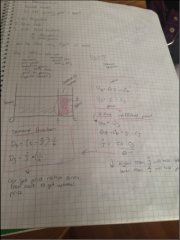![]()
![]()
![]()
Use LEFT and RIGHT arrow keys to navigate between flashcards;
Use UP and DOWN arrow keys to flip the card;
H to show hint;
A reads text to speech;
8 Cards in this Set
- Front
- Back
|
What are the different types of pricing regulations for pharmaceuticals?
|
1) No Regulation (ie US)
2) Price Cap 3) Exogenous reference pricing 4) Endogenous reference pricing |
|
|
Implications for no regulation
|
- Pb UP --> Pg UP
- Price reaction theory (from game theory) - Setting price in relation to other firms - If brand raises price, generic will raise price also |
|
|
Implications for price cap
|
- Pb CAP --> Pg UP
- Pricing of brand will go down, but price of generic will go up |
|
|
Implications for reference pricing
|
- Stimulated competition between brands and generics by reducing the brand's market share (about 15%)
- Shifts demands to generics, then brands have incentive to lower prices to regain market share |
|
|
How does reference pricing achieve cost savings?
|
- Shifts demand from brand to generics
- Reduces in brand name and generic prices |
|
|
Implications for exogenous reference pricing
|
- Firms take reference price as something outside themselves
- Pb DOWN --> Pg UP - Pg increases price because price becomes less elastic below reference price - No reason to charge less than govt's reimbursement price |
|
|
Implications for endogenous reference pricing
|
- Price becomes part of the reference price later
- Generic brands have incentive to lower prices to influence the reference price and increase market share - Will reduce reference price and force Pb to lower price - Pb DOWN Pg DOWN - In Norway, brand prices have fallen 33% and generic prices have fallen 22% |
|
|
Pharmaceutical model
|

|

